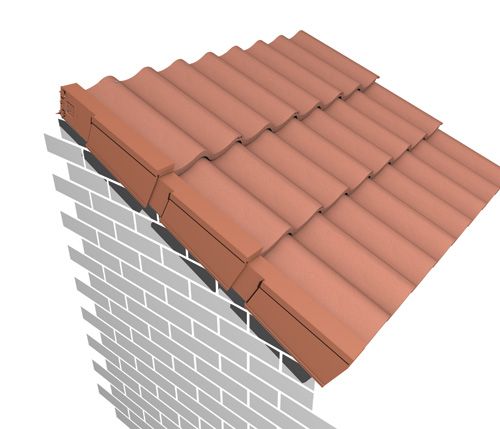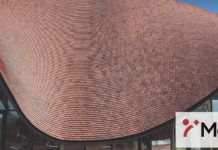 The roofing sector has been debating the benefits of dry fix over mortar bedding for ridges, verges and hip tiles for around 30 years. Now, finally, the introduction of the revised BS 5534 and technical guidance from NHBC means that dry fix is becoming the industry norm.
The roofing sector has been debating the benefits of dry fix over mortar bedding for ridges, verges and hip tiles for around 30 years. Now, finally, the introduction of the revised BS 5534 and technical guidance from NHBC means that dry fix is becoming the industry norm.
This is great news and something we, at Marley Eternit, have been campaigning for since we were one of the first manufacturers to launch dry fix systems back in the 1980s. The increasing use of dry fix is already having a positive impact on the security of pitched roofing, which can be seen in the reduction of mortar related claims received by the NHBC – dropping from 79% of roofing claims in 2011 to 51% in 2015.
However, the rise in the popularity of dry fix systems does bring its own challenges. As an industry we have spent so long pushing dry fix, that there is a misconception it is inherently durable when, in reality, it depends on the quality of the system used and how easy it is to fit. The market is becoming saturated with products and it is crucial that contractors can differentiate between the many systems on the market, which have huge variances in both quality and price.
It is hoped that the introduction of a new dry fix Standard in the near future will go some way to improving the overall quality of the products being sold into the industry as a whole.
When it comes to dry fix quality, one particular area of concern is dry verge systems. Permitting that a manufacturer’s interlocking dry verge has been tested and proven to provide sufficient uplift resistance, it can count as one of the two required mechanical fixings at the verge, so naturally for products that can demonstrate this, it is very important that it can perform this task robustly. Indeed, the correct and secure fixing of dry verge systems is continuing to come under greater scrutiny, particularly by warranty providers such as the NHBC, and contractors should be mindful of this when choosing and installing a dry verge product.
The decline in mortar use means that the dry verge market is huge and there are many products to choose from. Some of these are limited in compatibility and also value engineered to make them more affordable. This inevitably has implications on the performance and durability of the systems.
We were the first manufacturer to launch an interlocking dry verge system back in the 1980s and our original Dry Verge was a revolutionary product. Never being one to stand still, we continue to innovate in this area and are excited to be launching a new Universal Dry Verge system in January 2017. This takes the best features from our original version, with its aesthetics and quality, and builds on it to make the system even easier to fit, with what we feel is the greatest compatibility of anything currently on the market.
Whilst many dry verge products are sold as being universal, to date none have been compatible with all three main interlocking tile types; large standard, medium format (15” by 9”) and large format thin leading edge. For roofers, this usually means the hassle of buying different dry verge systems for various tile types. That’s why we have designed our new Dry Verge product with a unique internal rail system and leading edge hinge, so that it can be used with the majority of popular interlocking tile types from any manufacturer, as well as our own Lincoln clay pantile. This means contractors will only need to buy and carry one type of dry verge system for the majority of popular tile types.
Our own research has uncovered that a lot of roofing contractors dislike the starter verge fixing methods that many manufacturers provide. A number of common reasons were cited, ranging from general over-complexity, lack of visibility when installing, through to the general misconception that the verge will be installed before the gutter, which often isn’t the case and causes an obstruction. Again, our research has uncovered that in many cases, contractors have been either struggling to install the starter verge brackets or simply modifying them, using things like brick ties, to achieve a suitable fix to the fascia.
Therefore, our new system incorporates a brand new quick starter verge fixing method that can be installed easily regardless of any obstructions such as gutters. This has been designed and developed in conjunction with roofing contractors to provide an easy-to-install, robust method of securing the first verge unit – providing visible evidence to housebuilders and the NHBC of a correct and secure fix.
A common problem with cheaper systems is water leaking out of the verge and getting blown back onto the gable end, causing moss growth and staining. As with our original dry verge product, the new system includes our unique drainage features which help correctly channel rainwater to prevent this gable end staining. It is also made from an extremely durable form of polypropylene, which has outstanding weather resistance – particularly to freeze / thaw cycles and UV degradation. This means the installer gets a product that gives peace of mind in terms of product longevity and no call-backs.
Ultimately we want to protect the reputations of contractors and that is why we have spent time developing this new Universal Dry Verge system, based on roofer feedback, which will make it much easier to fix to British Standards.
Conclusion
There is no doubt that the introduction of BS 5534 and the use of dry fix as a standard method of installation has been a significant move in improving the security of pitched roofing in the UK. The next step is to ensure that roofing contractors are using quality products that will help to protect their reputations and reduce the need for call-backs. In the mean time, we highly recommend that contractors ensure they are choosing highly engineered systems that have been designed with reliability and performance, rather than affordability, in mind.



